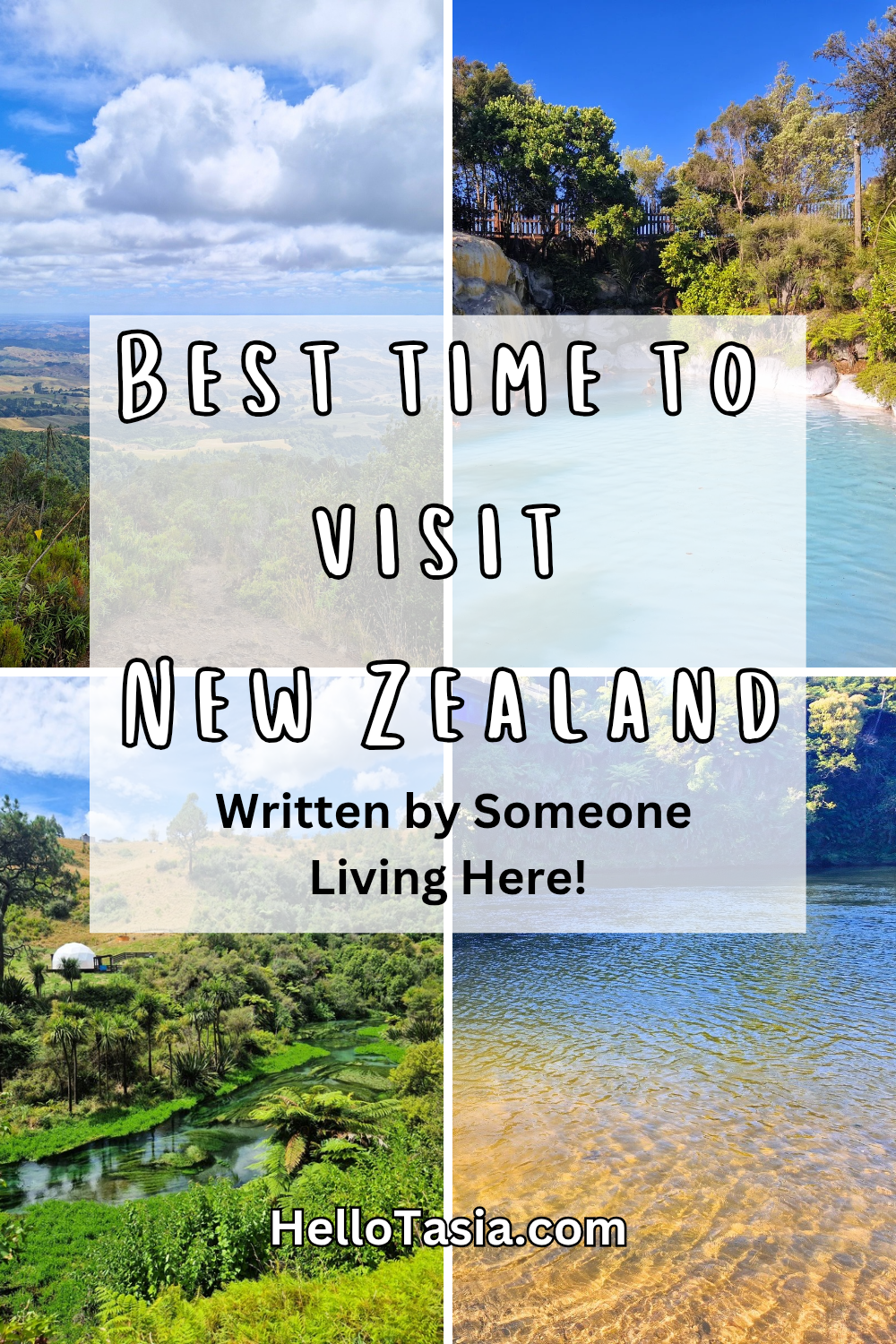New Zealand is a dream destination for many, offering breathtaking landscapes, adventure activities, and a unique cultural experience. But when is the best time to visit New Zealand? The answer depends on your travel style, budget, and the experiences you’re seeking. In this guide, we’ll break down the best times to visit based on weather, activities, and regional climate differences.
I am very fortunate to have moved to Hamilton, NZ so I am here to give you some insider information! You may also want to check cost of living in New Zealand before you plan your activities here.
New Zealand’s Seasons at a Glance
Since New Zealand is in the Southern Hemisphere, its seasons are opposite to those in North America and Europe:
- Summer (December – February): Warm weather, peak tourist season, ideal for beaches and hiking.
- Autumn (March – May): Mild temperatures, fewer crowds, stunning fall foliage.
- Winter (June – August): Best for skiing and snowboarding, fewer tourists in most regions.
- Spring (September – November): Blooming landscapes, mild weather, and fewer crowds.

Regional Climate Differences
New Zealand’s climate varies between the North and South Islands quite dramatically.
- North Island: Generally warmer with a subtropical climate in the far north. Summers are warm and humid, while winters are mild. In Hamiton, the average temperature at he peak of summer (February) is 21°C (70°F) and the average winter temperature during winter (August) is at 14°C (57°F).
- South Island: Cooler with an alpine climate in the interior and southern regions. Summers are warm, but winters can be cold with significant snowfall in mountainous areas. As an idea, January is the hottest month in Queenstown with an average temperature of 16°C (61°F) and the coldest is June at 4°C (39°F).
Seasonal Activities and Average Temperatures
Summer (December – February):
- Popular Activity: Marlborough Wine & Food Festival happens in February, celebrating the region’s wines and local cuisine. or in the North, you can see hot air baloons over Waikato in March!
- North Island Temperatures: Daytime: 22–26°C (72–79°F); Nighttime: 12–16°C (54–61°F).
- South Island Temperatures: Daytime: 20–25°C (68–77°F); Nighttime: 10–14°C (50–57°F).
Autumn (March – May):
- Popular Activity: you can see hot air baloons over Waikato in March!
- North Island Temperatures: Daytime: 17–23°C (63–73°F); Nighttime: 8–13°C (46–55°F).
- South Island Temperatures: Daytime: 15–21°C (59–70°F); Nighttime: 5–10°C (41–50°F).
Winter (June – August):
- Popular Activity: Hit the slopes in Queenstown and Wanaka, premier destinations for skiing and snowboarding.
- North Island Temperatures: Daytime: 12–16°C (54–61°F); Nighttime: 4–8°C (39–46°F).
- South Island Temperatures: Daytime: 7–12°C (45–54°F); Nighttime: -3–2°C (27–36°F).
Spring (September – November):
- Popular Activity: Witness the blooming of cherry blossoms in Christchurch’s Hagley Park.
- North Island Temperatures: Daytime: 16–20°C (61–68°F); Nighttime: 7–11°C (45–52°F).
- South Island Temperatures: Daytime: 15–19°C (59–66°F); Nighttime: 3–8°C (37–46°F).
Best Time to Visit New Zealand for Good Weather
If you’re after sunshine and outdoor activities, summer (December to February) is ideal. Expect warm temperatures, perfect for beaches, hiking, and exploring. It is also the busiest time due to school holidays. However, I find that the “busy” definition of New Zealand is nowhere near UK, as it’s there’s only 5 million people in the country (and another 5 million of tourist!!! Imagine if your country’s tourist population = resident population). For example, we went to Taupo on Auckland Anniversary day (public holiday), and it was really not that busy. We got free parking without difficulty in the middle of town and it didn’t feel crowded at all. This is Taupo, which is a renowned tourist spot.

For a balance of good weather and fewer crowds (and possibly cheaper tickets), late spring (October–November) and early autumn (March–April) are great choices. You’ll still enjoy pleasant temperatures but with fewer tourists. However, be mindful that the days are also getting shorter – if you want to do long hikes, then you may be a bit more limited.
For snowboarding, skiing and other winter activities, of course you should come during winter time. The best time to ski is between end of July to end of August, though the ski season is open from as early as June. June is less predictable for the snow, but it is a good time to snatch a bargain.
Best Time to Visit New Zealand for Budget Travelers
If you want to save money, the shoulder seasons—March to May (autumn) and September to November (spring)—are your best bet. Flights and accommodation are generally cheaper, and attractions are less crowded.
Winter (June to August) can also be budget-friendly, except in ski resort areas like Queenstown and Wanaka, where prices spike.
Best Time to Visit New Zealand for Adventure and Activities
- Skiing & Snowboarding: June (for budget), or end of July to end of August in the South Island.
- Hiking & Outdoor Adventures: October to April (summer and autumn are best).
- Wildlife Watching: Spring and summer are great for spotting whales, dolphins, and penguins.
- Wine Tours: Autumn (March to May) is ideal, as vineyards are in harvest season.

Worst Time to Visit New Zealand?
There’s no truly bad time to visit, but if you dislike crowds and high prices, avoid peak summer (December to February). If you’re not into winter sports, the cold months (June to August) may not be ideal for sightseeing especially in the North island where it rains more and the days are shorter.
Final Thoughts: When Should You Visit New Zealand?
The best time to visit New Zealand depends on your preferences. For warm weather and vibrant activity, go in summer. If you prefer fewer crowds and lower costs, try spring or autumn. Winter is fantastic for snow sports enthusiasts. No matter when you visit, New Zealand promises an unforgettable experience.
Planning a trip? Let me know if you need tips on specific destinations or itineraries!
Note: Temperature ranges are approximate and can vary year to year. Always check local forecasts in New Zealand Metrology Service (https://www.metservice.com) before your trip.

